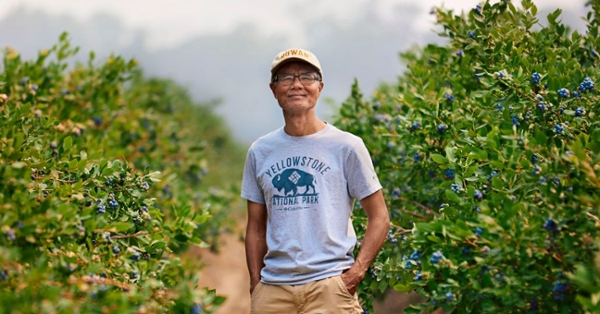Rowan mathematicians are at work in South Jersey’s blueberry fields
Rowan mathematicians are at work in South Jersey’s blueberry fields

Early in the summer, blueberry farmers estimate their crop production by walking up and down their fields, eyeballing bushes to make their best educated guess.
A couple years ago, Rowan University mathematics professors Hieu Nguyen, Ph.D., Thanh Nguyen, Ph.D. (no relation) and Ik Jae Lee, Ph.D., began working with farmers on a project using drones and artificial intelligence to better estimate crop yields. WATCH VIDEO.
With assistance from a hand-picked group of five students, the team used historical data provided by the farmers to create mathematical formulas, the driving force behind artificial intelligence.
To test and refine their models, the team spends a day early each summer flying drones over a blueberry field to photograph large areas, as well as individual bushes to serve as samples. Afterwards, they pick every berry from the sample bushes, sorting and counting them by hand, comparing their results with the algorithm’s estimate based on the images.
Because yield estimates are made early in the season, many berries are still small and green, making it difficult to distinguish unripened berries from leaves in photographs. Additionally, photographs can’t uncover berries hidden deep inside a bush, so current algorithms can only produce an estimated number. For Rowan mathematicians, coming up with new algorithms that will overcome these limitations and ensure precision poses an exciting problem to solve.
“That’s the challenge,” said the project’s leader, Hieu Nguyen, who began teaching at Rowan in 1996. “I look for challenges because that’s where you’ll be able to discover new, interesting patterns and theories.”
Precision agriculture is a fast-growing market, Nguyen noted, providing new opportunities for problem-solving. Last year, the New Jersey Department of Agriculture provided the group with a two-year, $39,000 grant to develop an automated method for identifying individual bushes affected by blueberry scorch, a plant disease spread by aphids. Next, the group hopes to work with cranberry producers to identify and map bogs invaded by a weed called Carolina redroot.
The algorithm relies on statistics and the team is only able to collect and count berries on a small number of bushes each season, so this phase of the project is planned to span several years. Additionally, the faculty are working to design better hardware necessary to deploy a self-directed drone for longer flights.
If such challenges are overcome, Nguyen said, he is confident his team will solve the problem.
“You’re essentially just trying to find the right formula to give you the correct answer,” he said. “It’s all math.”